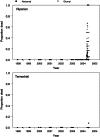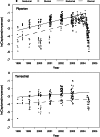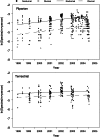Emerging infectious disease and the loss of biodiversity in a Neotropical amphibian community
- PMID: 16481617
- PMCID: PMC1413869
- DOI: 10.1073/pnas.0506889103
Emerging infectious disease and the loss of biodiversity in a Neotropical amphibian community
Abstract
Pathogens rarely cause extinctions of host species, and there are few examples of a pathogen changing species richness and diversity of an ecological community by causing local extinctions across a wide range of species. We report the link between the rapid appearance of a pathogenic chytrid fungus Batrachochytrium dendrobatidis in an amphibian community at El Copé, Panama, and subsequent mass mortality and loss of amphibian biodiversity across eight families of frogs and salamanders. We describe an outbreak of chytridiomycosis in Panama and argue that this infectious disease has played an important role in amphibian population declines. The high virulence and large number of potential hosts of this emerging infectious disease threaten global amphibian diversity.
Conflict of interest statement
Conflict of interest statement: No conflicts declared.
Figures




Comment in
-
Amphibian diversity: decimation by disease.Proc Natl Acad Sci U S A. 2006 Feb 28;103(9):3011-2. doi: 10.1073/pnas.0600293103. Epub 2006 Feb 21. Proc Natl Acad Sci U S A. 2006. PMID: 16492751 Free PMC article. No abstract available.
References
-
- Committee on Grand Challenges in Environmental Sciences . National Research Council Report: Grand Challenges in Environmental Sciences. Washington, DC: Natl. Acad. Press; 2001.
-
- Harvell C. D., Kim K., Burkholder J. M., Colwell R. R., Epstein P. R., Grimes D. J., Hofmann E. E., Lipp E. K., Osterhaus A. D., Overstreet R. M., et al. Science. 1999;285:1505–1510. - PubMed
-
- Daszak P., Cunningham A. A., Hyatt A. D. Divers. Distrib. 2003;9:141–150.
-
- McCallum H., Dobson A. Trends Ecol. Evol. 1995;10:190–194. - PubMed
-
- de Castro F., Bolker B. Ecol. Lett. 2005;8:117.
Publication types
MeSH terms
LinkOut - more resources
Full Text Sources
Other Literature Sources

